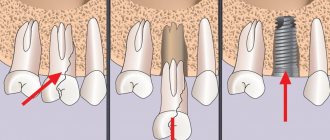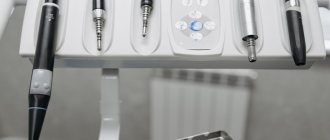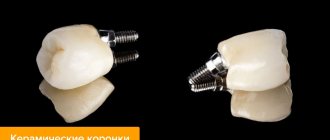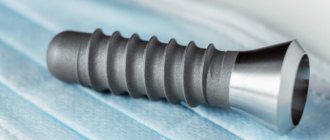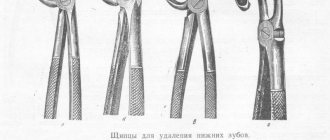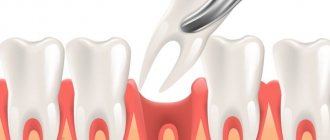How new dental implants are made and inserted if they cannot be placed without bone grafting
Dental plastic surgery involves increasing the volume of soft tissue on the gums when they are not enough. There are two ways to do this:
- Immediately transplant soft tissue if there are no contraindications during surgery.
- Natural growing and dividing the surgical procedure into two parts a few months apart.
This formation is necessary to give the jaw an attractive appearance and adjust the future smile accordingly. This issue becomes especially relevant when it comes to the front incisors, which are always in sight.
Drug treatment
Don't forget about cold compresses to reduce the likelihood of swelling - apply ice, a piece of meat or frozen vegetables, a container or ice pack wrapped in 2-3 layers of thin cloth to your cheek. The duration of the compress is 5-10 minutes, breaks are 3-5 minutes. The number of approaches is 7-10 times, for approximately 1.5-2 hours. Compresses should be started immediately upon returning home after surgery, and can also be repeated periodically during the first 24 hours.
Your doctor has prescribed painkillers for you. Monitor your condition - if necessary, you can take a pill at night or after you have stopped feeling the effect of anesthesia, that is, pain has appeared.
The list of prescriptions for each patient is individual and is indicated in the recommendations issued by the doctor. But in any case, you will be prescribed ointments to apply to the area of sutures, antibiotics (taken for at least 7 days, as prescribed by a doctor), antihistamines to reduce tissue swelling, drugs with a high content of vitamins C and P in the body (to improve the condition of the gums ), antiseptic agents for oral baths (do not rinse for the first 3 days - just keep the solution in the mouth).
Calculation of dental implants for implantation: how they fit in
For each specific case, the doctor determines the amount individually. It depends on the structural features of the oral cavity, the volume of soft tissues, and other indications. Please note that only a qualified specialist can correctly calculate the chewing load.
The general practice is to start with ten pins in each jaw if the patient is completely edentulous. If the installation position is correctly calculated, a good result can be obtained using six or eight support elements.
Installing many implants is expensive. Therefore, people with limited income strive to reduce their number. A properly made prosthesis will distribute the load evenly. But, in this matter, it is recommended to exercise healthy wisdom and choose the best option, based on the recommendations of a specialist.
The next question that is often asked in the dentist’s chair is: what material should the pin be made of? There are many elements used in this field, therefore, only a qualified specialist can determine the appropriate ones based on contraindications.
A competent doctor will offer several options to choose from that can solve the problem, so that the patient can independently choose the one that is suitable for the price.
Which implants are suitable for upper teeth
For implantation in the area of the front part of the dentition, implants of small diameter and longer are used. They are installed in the deeper, denser basal layer of bone, which makes it possible to avoid the need for bone tissue augmentation. Such implants are easier to install at the desired angle to further enhance the beauty of your smile. Larger diameter implants are installed on the sides. Implants are made from titanium, zirconium and some complex alloys.
Titanium
Titanium alloys of classes 4 and 5 are mainly used for the manufacture of implants. They are durable, reliable and compatible with human tissue. For the anterior teeth of the upper jaw, white zirconium dioxide abutments are installed on black titanium roots - this allows the prosthesis to maintain a uniform white color.
Zirconium and aluminum oxide
Zirconium dental implants in the upper jaw are white in color and highly durable. They are placed mainly on the front surface of the dentition, since titanium roots often show through the gums, disrupting the aesthetics of the smile. Zirconium abutments are also used for them. Aluminum oxide is also a very durable white material and is used to make beautiful white implants for implantation in the smile area.
Titanium and zirconium implants
Other materials
Roxolid is a combined composition consisting of titanium alloys 4 cass and zirconium dioxide. It has a gray color and the highest strength. A special feature of this compound is its ability to activate the process of implant engraftment in the maxillary tissues. Suitable for implantation of any degree of complexity, both for the production of classic implants and thinner ones for the smile area.
Crowns are important too
Prostheses made from different materials are used. Crowns for the front surface of the dentition are especially carefully selected. This is done after whitening the patient’s teeth. The following materials are used:
- metal and metal-ceramic - dentures for chewing units only; metal ceramics in the smile area look unaesthetic, as they turn slightly gray over time;
- dental ceramics is a beautiful but fragile material, dentures made from it are suitable for the smile area;
- zirconium dioxide is also a beautiful white and durable material, suitable for making dentures for any unit of the dentition;
- zirconium dioxide coated with ceramics is a type of combined material, beautiful durable dentures, placed on both the front and side surfaces of the dentition.
How is rehabilitation going: what to do
The postoperative period is always accompanied by recovery measures that promote a speedy recovery.
In the first days, it is not recommended to even rinse your mouth. This will wash away the blood molecules that are responsible for wound healing. To maintain hygiene, you can gently clean, including the temporary crown. For this, soft brushes are used, and movements should be very smooth and careful. It is better to choose a paste with antiseptic additives.
Sauna, solarium, bathhouse, heavy lifting and excessive stress are completely contraindicated during this period. The appearance of any, even the most fleeting, unpleasant sensations indicates the need to see a dentist.
An example of a one-stage implantation operation with immediate loading
Let's consider a specific example - a fracture of a front tooth at the root.
In such cases, the most reliable, durable and predictable form of prosthetics is the implantation of a missing tooth. The picture shows that the tooth was previously treated endodontically. The following treatment plan was proposed: tooth extraction followed by immediate implantation and installation of a temporary crown, installation of a permanent crown after the implant has healed. The patient approved of this plan. Let's look at the operation step by step.
Before the operation, the patient passed all the necessary tests, the oral cavity was sanitized and prepared for surgery.
In the photo, the root of the tooth has just been removed. Simultaneous implantation and installation of a temporary crown are planned.
It is very important to remove the root of the tooth as carefully as possible. Alveolar bone should be preserved as much as possible. For better implant healing, a platelet-rich clot was used.
Installation and adjustment of the plastic abutment. A plastic abutment with such a purpose that it should break before the load is transferred to the bone (in case of an emergency).
In the following photos, a temporary crown blank is installed on the implant. It will be polished, removed from the bite and temporarily glued to the adjacent teeth. This is done in order to reduce the load on the implant on which it is installed until it heals. The crown is also shown after completion of its aesthetic design.
Approximately one hour after tooth root removal, the patient resolves the aesthetic issue and does not experience discomfort during communication. He calmly waits until the implant takes root and it becomes possible to install a permanent crown.
Approximately 40 minutes passed from the moment the tooth was removed until the last photo was taken.
Indications and contraindications
Bone tissue is formed in girls up to eighteen years old, and in boys up to twenty-one years old. Therefore, the installation of pins during this period is strictly prohibited. There is no upper age limit for the procedure.
In case of blood clotting disorders, as well as regeneration of soft and hard tissues, this surgical intervention can become critical for life. People with an unbalanced psyche or pregnant women are also not allowed to undergo the procedure.
In other cases, nothing limits the patient. However, it should be remembered: this manipulation must be performed by a qualified specialist after a mandatory preliminary examination.
Indications for use are:
- complete or partial loss of supporting elements of the jaw, on which removable dentures can be attached;
- allergic reactions to materials;
- inability to use alternative options for other reasons.
Photos of the surgical stage of dental implantation
X-rays are used to check the correct installation of the dental implant.
- After the implants have healed, 2 months later, final prosthetics are performed. 6 visits to the clinic.
The x-ray shows complete healing of the implants.
After the implants have healed, the gums are opened and a gum former is screwed into the implant to expand the gums around the neck of the future tooth, since it will be wider than the implant. After the gums have formed, you can begin prosthetics on implants.
Temporary plastic crowns were made for the patient during prosthetics.
Metal-ceramic crowns were manufactured in our own dental laboratory.
View of installed crowns from different angles.
Alternatives to implantation
If there are no teeth in the lower jaw, or some of them are in poor condition and must be removed, prosthetics can be done using a removable structure. Modern dentures are made from soft plastics; they are fixed quite well on the gums, fitting tightly to the mucous membranes. However, compared to dentures that are fixed on implants, removable structures are more massive, take a long time to get used to, and over time become a little “loose” - due to the risk of falling out, the patient has to additionally use dental glue.
The second option is to install a dental bridge. The denture is permanent, but its fixation requires at least two living teeth in good condition. They are turned down, since the crowns that are part of the dental bridge are fixed on top. The prosthesis is comfortable and aesthetic. But the teeth of the lower jaw bear an increased load, so bridges do not last long - the supporting teeth are destroyed, which most often cannot be restored.
The main disadvantage of removable and bridge prostheses is the lack of load on the bone. They restore only the visible, crown part of the tooth, and the bone tissue, as in the absence of teeth, ceases to receive load - the process of its atrophy continues. This is fraught with subsidence of the prosthesis along with the gums, as well as the appearance of a small gap under it, in which plaque accumulates - this is a direct path to inflammatory processes of the periodontium.
1 According to the International implant foundation.2 According to clinical studies from Nobel, Straumann, International implant foundation.
How long does it take for the structure to take root on the lower jaw?
The speed of engraftment is affected by:
- State of health and age of the patient . The younger the person, the faster the healing process will take place. Chronic diseases can slow down engraftment.
- Preparing for surgery . A thorough history and examination of the oral cavity is important. The engraftment process is also influenced by the experience and qualifications of the doctor. Before the operation, the specialist must carry out the necessary hygiene procedures and research to obtain information about the state of health and identify contraindications.
- Correct selection of implant model . A rod that is too short and thick simply will not fit into the jawbone. Excessively long can injure tissue. The quality of the material also influences the engraftment process.
- Actions of the implantologist . If no rejection occurs during the first days, and no complications arise during implantation, we can talk about the success of the operation.
- On which jaw was the implantation performed ? It takes root faster on the lower jaw, since its structure is more dense. The bone of the upper row has a loose structure due to the large number of airways it contains.
- Compliance with the dentist's recommendations. In the postoperative period, it is important to maintain oral hygiene, take prescribed medications and visit the dentist in a timely manner.
In the first weeks after surgery, damaged bone tissue is restored, and trabecular bone is formed around the rod. This type of bone is fragile and cannot withstand chewing loads. It takes at least 18 weeks for the formation of a strong structure, called lamellar. This bone fills the gaps between the dental structure and jaw tissue, and is able to withstand the chewing process.
On average, an implant takes 4 months to take root in the lower jaw, and six months in the upper jaw.
Implants for chewing teeth - patient reviews
Patient reviews of the procedure for implanting chewing teeth are almost always positive, since today this technique allows you to be almost 100% confident in a good final result. Negative impressions are usually associated with the unprofessionalism of the doctor and an incorrectly performed implantation procedure. As for reviews of implants for chewing teeth from specific manufacturers, the leading brands include Nobel Biocare, Straumann and Astra Tech.
In any case, classical dental implantation can be performed only in the absence of serious contraindications, which include diseases of the immune system and periodontal disease, cancer and diabetes. If such restrictions exist, tooth restoration is carried out in other ways.
Lifestyle after surgery: general recommendations
- avoid physical activity, do not lift weights - you must stop doing sports in the next month after implantation,
- avoid hypothermia and overheating - it is recommended to avoid visiting baths, saunas, swimming pools, swimming in the sea/lake also for 1 month,
- stop smoking (if possible) and drinking alcoholic beverages,
- in the first 3-5 days you should avoid air travel,
- If an implantation of the upper jaw has been performed, including a sinus lift procedure (displacement of the maxillary sinus), you must cough, sneeze and blow your nose very carefully - without opening your mouth or puffing out your cheeks (after bone augmentation, any pressure changes and overloads are prohibited).
Checklist: a general list of what to prepare after implantation
Prepare a sleeping place in advance, stock up on interesting films or favorite music - they will help you distract yourself on the first day after surgery and not focus on every sensation. The body has suffered stress and the tissues begin to rehabilitate – discomfort is normal.
| WHAT TO BUY AT A PHARMACY | WHAT TO BUY | WHAT TO COOK AT HOME |
|
|
|
